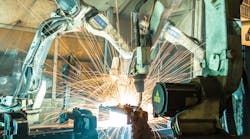U.S. manufacturing production just had its best year since 2011, yet some argue that 2017 was as good as it will get and that a slowdown is ahead.
We think the opposite is more likely: Factory output is poised to speed up. Investors worried that the equity market is stretched should take heart. Stronger growth in factory output is a good reason to remain cyclically oriented, especially in U.S. industrial stocks.
Trade, one of the biggest engines of the sector in 2017, is likely to continue to gather momentum. Stronger global growth expectations and a weaker dollar should help as manufacturing goods represent about half of all exports.
Moreover, at least some of the current recovery in factories can be traced to the rebound in the mining industry. Mining output declined steadily from December 2014 to September 2016. Production was down 0.6 percent during this period, when there was also a sharp pullback in oil and drilling equipment. Today, we are seeing the opposite dynamic. With commodity markets in recovery, mining-related investment is more of a tailwind to factories.
While the global economy is a big driver of manufacturing growth, U.S. domestic demand is even more important. Every 1 percentage point increase in domestic demand (GDP net of trade) boosts manufacturing production by 1.34 percentage point on an annualized basis, while every 1 percentage point increase in global industrial production outside the U.S. lifts domestic manufacturing production by 0.44 percentage point.
There are several positive, somewhat related signs for the manufacturing outlook in the domestic economy.
First, U.S. inventory investment is simply too low. Although the contribution of inventories to growth can be volatile from quarter to quarter, inventories tend to grow in line with final sales over longer periods of time. Today, that simply is not happening; inventories have been trailing the growth in domestic demand. If the economy expands at 2.2 percent, the rough trend since the end of the recession, inventories would need to grow by about $50 billion per year to keep pace with demand. Inventories ran below that level in 2017. That means factories are likely to go into overdrive to boost inventories in coming quarters.
The auto industry is a prime example. After Hurricanes Harvey and Maria, a replacement rebound in auto sales took a bite out of inventories. With sales continuing to come in somewhat stronger than expected, there is a good chance carmakers will ramp up their production schedules for this year.
Second, the recovery in business investment should help lift the factory sector. After all, about one-tenth of total industrial production is business equipment. Typically, when labor markets are tight, companies seek alternative ways to meet demand. Business fixed investment tends to be stronger when the unemployment rate is below the non-accelerating inflation rate of unemployment, or NAIRU, as it is widely expected to be today. Loose financial conditions will also help. Stronger stock prices have a tendency of helping ease lending standards on commercial and industrial loans, which, in turn, lead investment spending.
Third, the housing market is on the mend. Construction supplies and appliances represent about 5 percent of total industrial production. Nevertheless, both areas, like the housing market more broadly, remain well below prior cyclical peaks. Housing demand continues to outrun supply and builder sentiment is elevated. Expect construction activity to strengthen in the coming year, providing a tailwind for manufacturing.
In short, don't expect manufacturers to slow down any time soon; there's plenty of reason for solid growth ahead.










